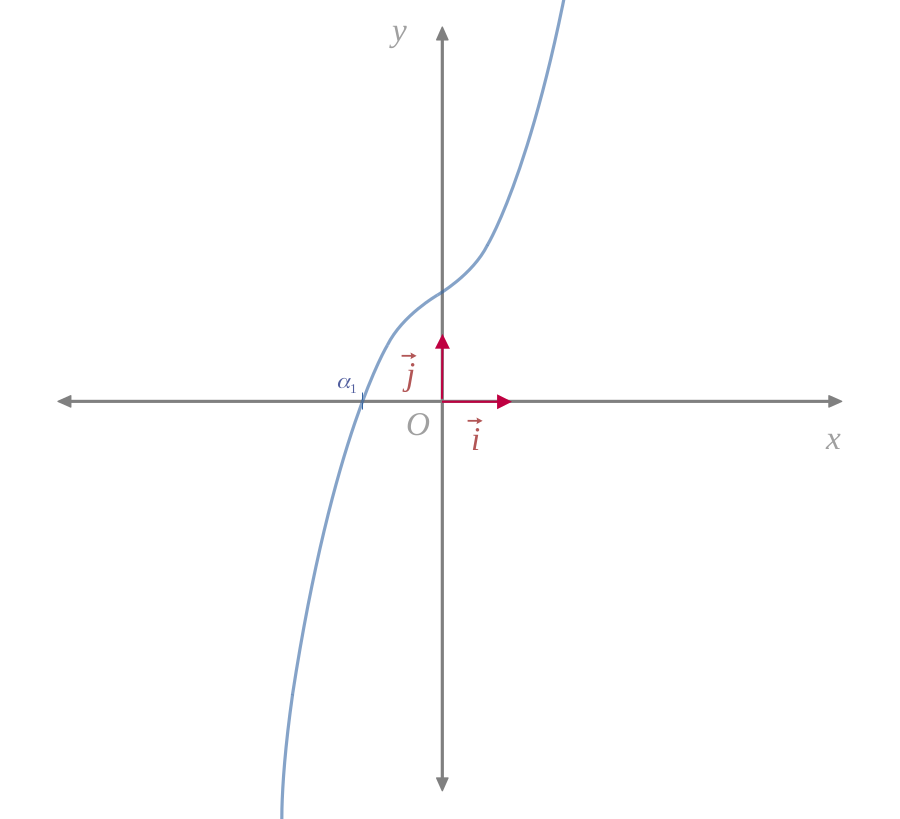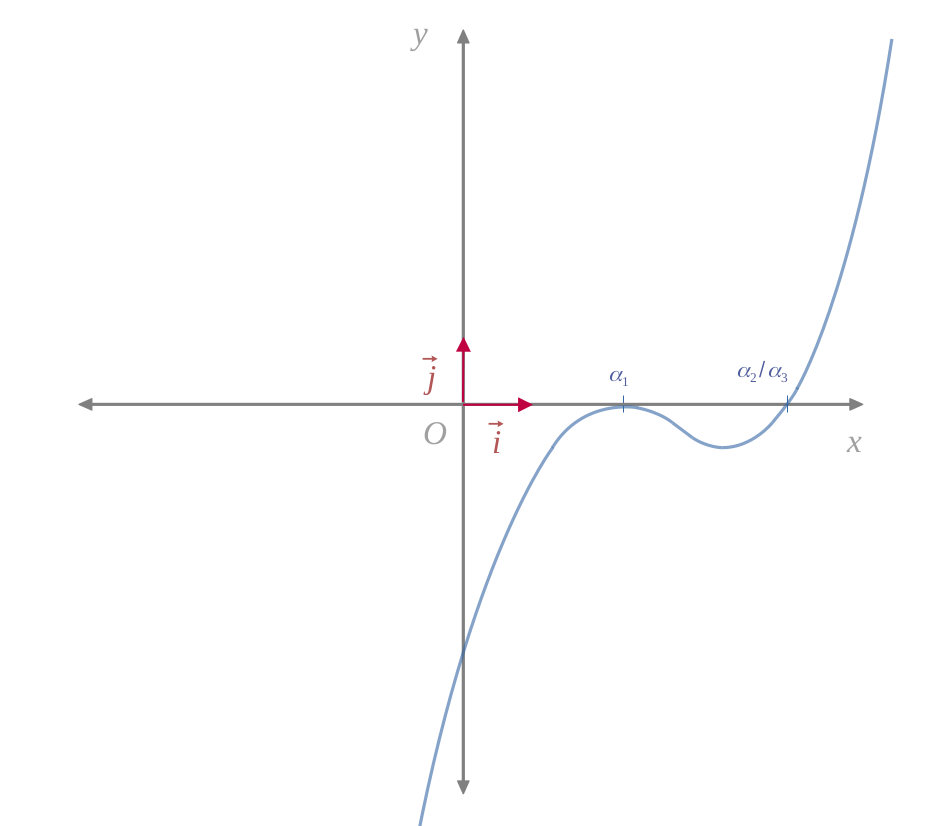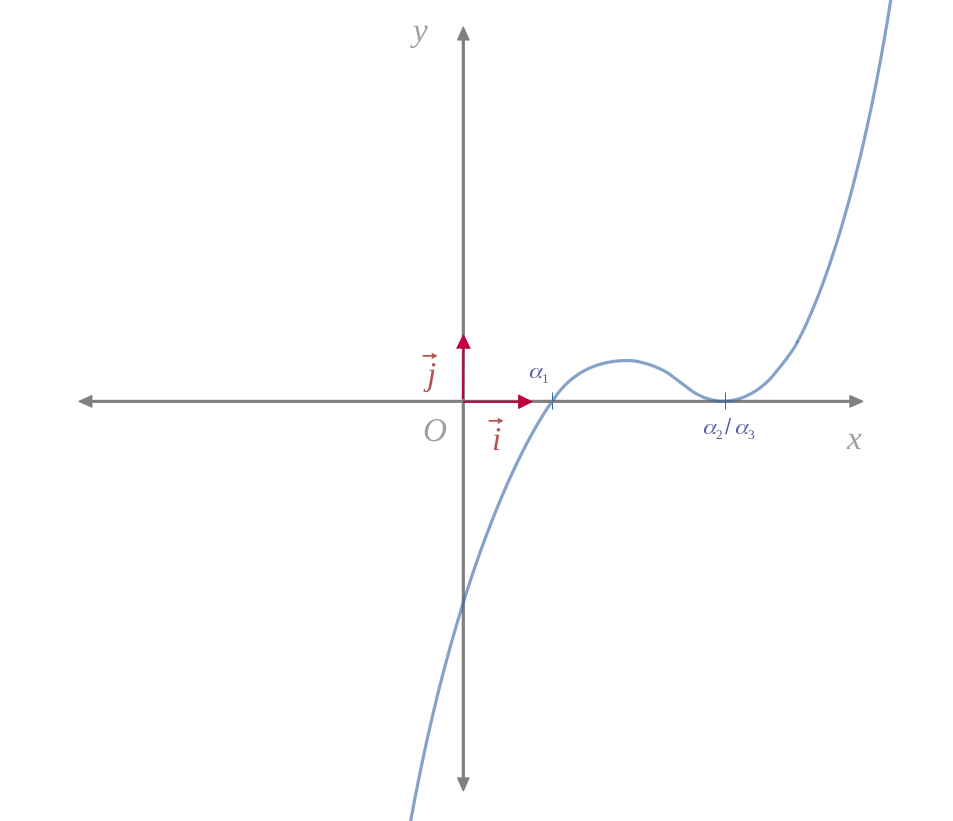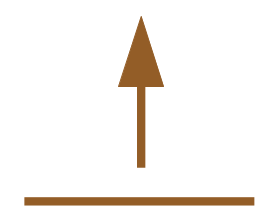



A third degree equation is of the form:
If there are one or more obvious roots, then the polynomial can be factored and reduced to a lower degree.
After calculating the discriminant \(\Delta_3\) :
We do have the following number of real roots depending on the cases:
|
Signe of the discriminant \( \Delta_3 \)
|
Number of roots
|
|---|---|
|
$$ \Delta_3 > 0 $$
|
1 real root
|
|
$$ \Delta_3 = 0 $$
|
3 real roots (including one double)
|
|
$$ \Delta_3 < 0 $$
|
3 real roots
|
if \( (\Delta_3 > 0) \)
a simple real root
two complex roots
And \( P_3(X) \) can be factorized as follows:
if \( (\Delta_3 = 0) \)
a simple real root
a double real root
And \( P_3(X) \) can be factorized as follows:
if \( (\Delta_3 < 0) \)
three real roots
Even though they appear in a complex form, after solving these solutions definitely become real.
And \( P_3(X) \) can be factorized as follows:
A third degree equation is of the form:
So, we are trying to solve:
If there are one or more obvious roots, then the polynomial can be factored and reduced to a lower degree.
In the general case, we can use a graphical approach to determine the number of roots according to the different cases.
We start from the equation \( (1) \) :
We factor by \( a \) :
From this point on, we will keep in mind that the general form \((2)\) contains \(a\) as a factor, but we will study the function inside the parenthesis:
We then seek to eliminate the second degree term.
We try to determine the real number \(\alpha \in \mathbb{R}\) such as the following change of variable:
eliminates the second-degree term.
We then expand our starting polynomial with the change of variable, in order to identify \(\alpha\). So, we start again with the expression \((2^*)\),
and we apply the change:
We develop the expression:
Then we arrange it:
Seeking to eliminate the second degree term, this amounts to determining \(\alpha\) such as:
We then have made our change of variable:
Let us also determine the correspondence between the coefficients \((a,b,c,d)\) and \((p,q)\), starting from \((3)\) :
but without the second degree term of the right-hand member, which disappeared following the change of variable.
This ultimately gives us:
The expression \((2^*)\) then becomes:
We will then study the function \((f)\):
Let us note from now on that \(f\) is an odd function, being the sum of odd functions.
Next, let's try to derive this function:
Let's factor this derivative \(f'\).
And let us seek these roots:
Let there be two roots:
So, we can rewrite it in its factorized form:
|
$$ \chi $$
|
$$ -\infty $$
|
|
$$ \chi_1 = -\sqrt{- \frac{p}{3}} $$
|
|
$$ \chi_2 = \sqrt{- \frac{p}{3}} $$
|
|
$$ +\infty $$
|
|---|---|---|---|---|---|---|---|
|
$$ \chi + \sqrt{- \frac{p}{3}} $$
|
$$ \textcolor{#A45959}{-} $$
|
$$ \textcolor{#A45959}{-} $$
|
$$ 0 $$
|
$$ \textcolor{#4A8051}{+} $$
|
$$ \textcolor{#4A8051}{+} $$
|
$$ \textcolor{#4A8051}{+} $$
|
$$ \textcolor{#4A8051}{+} $$
|
|
$$ \chi - \sqrt{- \frac{p}{3}} $$
|
$$ \textcolor{#A45959}{-} $$
|
$$ \textcolor{#A45959}{-} $$
|
$$ \textcolor{#A45959}{-} $$
|
$$ \textcolor{#A45959}{-} $$
|
$$ 0 $$
|
$$ \textcolor{#4A8051}{+} $$
|
$$ \textcolor{#4A8051}{+} $$
|
|
$$ f'(\chi) = \left(\chi + \sqrt{- \frac{p}{3}} \right)\left(\chi -\sqrt{- \frac{p}{3}} \right) $$
|
$$ \textcolor{#4A8051}{+} $$
|
$$ \textcolor{#4A8051}{+} $$
|
$$ 0 $$
|
$$ \textcolor{#A45959}{-} $$
|
$$ 0 $$
|
$$ \textcolor{#4A8051}{+} $$
|
$$ \textcolor{#4A8051}{+} $$
|
|
$$ f(\chi) = \chi^3 + p\chi + q $$
|
$$ - \infty $$
|
 |
$$ f(\chi_1) $$
|
 |
$$ f(\chi_2) $$
|
 |
$$ + \infty $$
|
As the function \(f\) change de sens de variations changes direction of variations before \(\chi_1\) and after \(\chi_2\), it therefore has two inflection point in \(\chi_1\) and \(\chi_2\).
And as we know that \( P_3(\chi)\) is worth:
The variation table of \(P_3(\chi)\) will be that of \(f(\chi)\) if \((a > 0)\), but will be reversed if \((a < 0)\).
Let's look for the values of the images \( f\left(\chi_1 \right) \) and \( f\left(\chi_2 \right) \) :
For \( \chi_1 = - \sqrt{- \frac{p}{3}}\) :
For \( \chi_2 = \sqrt{- \frac{p}{3}}\) :
To know the number of roots of \(f(\chi)\), we try to know the sign at a given instant of the product of these two images.
which we will call third-degree discriminant \(\Delta_3\):
We will then have three sub-cases to consider:
For each case, there will always be its complement in the case of a negative coefficient in front of the third degree term, which only reverses the shape of the curve, but preserves the root values.
If the discriminant is positive, this means that \(f\left(\chi_1\right)\) and \(f\left(\chi_2\right)\) are of the same sign, therefore:
According to the variation table of \(f\), there will be only one real root, located between \((\chi = -\infty)\) and \((\chi = \chi_1)\).
|
$$ \chi $$
|
$$ -\infty $$
|
$$ \textcolor{#6187B2}{\alpha_1} $$
|
$$ \chi_1 = -\sqrt{- \frac{p}{3}} $$
|
|
$$ \chi_2 = \sqrt{- \frac{p}{3}} $$
|
|
$$ +\infty $$
|
|---|---|---|---|---|---|---|---|
|
$$ f(\chi) = \chi^3 + p\chi + q $$
|
$$ - \infty $$
|

$$ \textcolor{#6187B2}{f(\alpha_1) = 0} $$
|
$$ \textcolor{#4A8051}{f(\chi_1) > 0} $$
|
 |
$$ \textcolor{#4A8051}{f(\chi_2) > 0} $$
|
 |
$$ + \infty $$
|

According to the variation table of \(f\), there will be only one real root, located between \((\chi = \chi_2)\) and \((\chi = +\infty)\).
|
$$ \chi $$
|
$$ -\infty $$
|
|
$$ \chi_1 = -\sqrt{- \frac{p}{3}} $$
|
|
$$ \chi_2 = \sqrt{- \frac{p}{3}} $$
|
$$ \textcolor{#6187B2}{\alpha_1} $$
|
$$ +\infty $$
|
|---|---|---|---|---|---|---|---|
|
$$ f(\chi) = \chi^3 + p\chi + q $$
|
$$ - \infty $$
|

|
$$ \textcolor{#A45959}{f(\chi_1) < 0} $$
|

|
$$ \textcolor{#A45959}{f(\chi_2) < 0} $$
|

$$ \textcolor{#6187B2}{f(\alpha_1) = 0} $$
|
$$ + \infty $$
|
In both cases, there will be only one real root.
If the discriminant is zero, this means that one of the two images is zero, because according to the variation table, we always have:
In this case, there will be a double root for \((\chi = \chi_1)\), and another root for \((\chi_2 < \chi < +\infty)\).
|
$$ \chi $$
|
$$ -\infty $$
|
|
$$ \textcolor{#6187B2}{\alpha_1 / \alpha_2 = \chi_1} $$
|
|
$$ \chi_2 = \sqrt{- \frac{p}{3}} $$
|
$$ \textcolor{#6187B2}{\alpha_3} $$
|
$$ +\infty $$
|
|---|---|---|---|---|---|---|---|
|
$$ f(\chi) = \chi^3 + p\chi + q $$
|
$$ - \infty $$
|

|
$$ \textcolor{#6187B2}{f(\chi_1) = 0} $$
|
 |
$$ \textcolor{#A45959}{f(\chi_2) < 0} $$
|

$$ \textcolor{#6187B2}{f(\chi_2) = 0} $$
|
$$ + \infty $$
|

Dans ce cas symétrique, il y aura une racine simple pour \((\chi_2 < \chi < +\infty)\), ainsi qu'une racine double pour \((\chi = \chi_1)\).
|
$$ \chi $$
|
$$ -\infty $$
|
$$ \textcolor{#6187B2}{\alpha_1} $$
|
$$ \chi_1 = -\sqrt{- \frac{p}{3}} $$
|
|
$$ \textcolor{#6187B2}{\alpha_2 / \alpha_3 = \chi_2} $$
|
|
$$ +\infty $$
|
|---|---|---|---|---|---|---|---|
|
$$ f(\chi) = \chi^3 + p\chi + q $$
|
$$ - \infty $$
|

$$ \textcolor{#6187B2}{f(\alpha_1) = 0} $$
|
$$ \textcolor{#4A8051}{f(\chi_1) > 0} $$
|
 |
$$ \textcolor{#6187B2}{f(\chi_2) = 0} $$
|
 |
$$ + \infty $$
|

In both cases, we will have a double real root and a simple real root.
The double root necessarily lies on the plateau, because in the other case the function is strictly increasing.
If the discriminant is negative, the two images \(f(\chi_1)\) et \(f(\chi_2)\) are of opposite signs.
As we know that:
there is only one case, and we will distinguish three real roots.
|
$$ \chi $$
|
$$ -\infty $$
|
$$ \textcolor{#6187B2}{\alpha_1} $$
|
$$ \chi_1 = -\sqrt{- \frac{p}{3}} $$
|
$$ \textcolor{#6187B2}{\alpha_2} $$
|
$$ \chi_2 = \sqrt{- \frac{p}{3}} $$
|
$$ \textcolor{#6187B2}{\alpha_3} $$
|
$$ +\infty $$
|
|---|---|---|---|---|---|---|---|
|
$$ f(\chi) = \chi^3 + p\chi + q $$
|
$$ - \infty $$
|

$$ \textcolor{#6187B2}{f(\alpha_1) = 0} $$
|
$$ \textcolor{#4A8051}{f(\chi_1) > 0} $$
|

$$ \textcolor{#6187B2}{f(\alpha_2) = 0} $$
|
$$ \textcolor{#A45959}{f(\chi_2) < 0} $$
|

$$ \textcolor{#6187B2}{f(\alpha_3) = 0} $$
|
$$ + \infty $$
|

In summary, here are the cases according to the result of the discriminant \(( \Delta_3 = q^2 + \frac{4p^3}{27} )\):
|
Sign of the discriminant \( \Delta_3 \)
|
Numbers of roots
|
|---|---|
|
$$ \Delta_3 > 0 $$
|
1 real root
|
|
$$ \Delta_3 = 0 $$
|
3 real roots (including one double)
|
|
$$ \Delta_3 < 0 $$
|
3 real roots
|
The following part will be treated using Vieta's substitution method.
Let's briefly summarize the path taken in the previous point. We started from the equation to be solved \((1)\):
Then, we factorized by \(a\) :
The \(a\) factor not changing the roots, we can get rid of it:
and make a first change of variable.
Having posed the change of variable:
We then arrived at:
We now pose a new change of variable:
Which gives us:
We develop the expression:
Now multiplying by \(w^3\), we obtain that:
We now have a second-degree equation by once again introducing a new variable:
Finally, we put down:
So, the expression\((4^*)\) now becomes:
With this second-degree equation, we can calculate the second degree discriminant, which we will call as above \(\Delta_3\) :
With the equation \((5)\):
If \( (\Delta_3 > 0) \), we obtain two real solutions:
Which can be arranged in:
We made these different variable changes as a result:
You must therefore reassemble them in the opposite direction:
Taking the cube root of \(z\), we will have as coefficient the three roots of unity which are three unit roots of a complex number which are \( \Bigl \{1, \ e^{\frac{2i\pi}{3}}, \ e^{-\frac{2i\pi}{3}} \Bigr \} \), which gives us six roots in all:
The six expressions then become:
Then, we multiply the numerators and denominators by their respective conjugates.
For the first pair of solutions \(\chi_1 / \chi_2 \):
These two roots are actually one, because of double signs \(\pm\) and \(\mp \) present in each of the first two terms:
For the other two pairs of solutions \((\chi_3 / \chi_4, \ \chi_5 / \chi_6)\), we follow the same approach, and after calculations we arrive at the following forms:
For them too, we can group them together because they are two by two identical:
For this last step, we just have to add to each solution the term \(-\frac{b}{3a}\).
We saw this equality above:
So, we put this equality back in place for the presentation of the solutions.
In this case of \( (\Delta_3 > 0) \) we then have that:
a simple real root
two complex roots
Hence, the polynomial \(P_3(X)\) admits the following factorization:
With the equation \((5)\):
if \( (\Delta_3 = 0) \), we have a real double solution:
In the same way as above, we go back through the different variable changes one after the other.
For the fisrt solution \(\chi_1 \):
But as:
(voir plus haut)
And that we have as hypothesis that \( \Delta_3 = 0 \), then:
And so that:
Which also implies that:
We can then replace in the previous expression:
Now, we can make the power formulas work:
For the other two solutions:
These two solutions are one and the same solution:
In this case of \( (\Delta_3 = 0) \) we then have that:
a simple real root
a double real root
Hence, the polynomial \(P_3(X)\) admits the following factorization:
With the equation \((5)\):
If \( (\Delta_3 < 0) \), we do obtain two complex solutions:
Which can be arranged as previously in:
In the same way as above, we go back through the different variable changes one after the other.
The six expressions then become:
For the first couple of solutions \(\chi_1 / \chi_2 \):
These two solutions are one and the same solution.
For the other two pairs of solutions \((\chi_3 / \chi_4, \ \chi_5 / \chi_6)\), we follow the same approach, and after calculations we arrive at the following forms:
In the same way as above, we get rid of the absolute value in the presentation of the results.
In this case of \( (\Delta_3 < 0) \) we then have that:
three real roots
Even if they appear in complex form, after solving these solutions definitely become real.
Hence, the polynomial \(P_3(X)\) admits the following factorization:
We do notice that \( (X = -1) \) is an obvious root. Let us try to find the second-degree polynomial having coefficients \((\alpha, \beta, \gamma)\) such as:
Let us make a polynomial division to find it:
|
$$$$
|
$$ X + 1 $$
|
|---|---|
|
$$\hspace{1em} X^3 + X^2 + X + 1 $$
|
$$ \textcolor{#4A8051}{X^2} $$
|
|
$$ \textcolor{#AF5F5F}{-X^3} \textcolor{#AF5F5F}{-X^2} + X + 1 $$
|
$$ X^2 $$
|
|
$$ \hspace{1em} 0 \hspace{1.2em} + \hspace{0.2em} 0 \hspace{0.4em} \textcolor{#AF5F5F}{-X - 1} $$
|
$$ X^2 \textcolor{#4A8051}{+ 1} $$
|
As a result,
We now seek its roots.
As \(\Delta\) is negative, there is two complex roots:
So, the solution of \( \Bigl[ P_3(X) = 0 \Bigr] \) are:
\(P_3(X) \) can than be factorized as follows:
We compute the third-degree discriminant \(\Delta_3\):
As \(\Delta\) is worth zero, we do have three real roots:
a simple real root
a double real root
\(Q_3(X) \) can than be factorized as follows:
 Go to the top of the page
Go to the top of the page